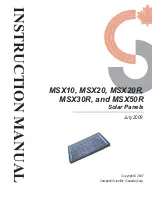
EN-Rev IM/IEC-AM-EN/3.6 Copyright © March 2017. Canadian Solar Inc.
6 |
5.0
MODULE INSTALLATION
PRECAUTIONARY MEASURES AND
GENERAL SAFETY
· Prior to installing modules please obtain
information about any requirements and
necessary approvals for the site, installation and
inspection from the relevant authorities.
· Check applicable building codes to ensure that the
construction or structure (roof, facade, support,
etc.) can bear the module system load.
· CS-series solar modules have been qualified for
Application Class A (equivalent to Safety Class II
requirements). Modules rated under this class
should be used in systems operating at voltage
above 50 V or power above 240 W, where general
contact access is anticipated.
· When installing modules, please ensure the sup-
porting roof has a fire resistant roof covering rated
for the application. Canadian Solar Inc. modules
are listed as Class C under the UL790 standard.
· The fire rating for this module is only valid when
the product is installed as specified in the mechani
-
cal mounting instructions.
ENVIRONMENTAL CONDITIONS
· The module is intended for use in general
open-air climates, as defined in IEC 60721-2-1:
Classification of environmental conditions Part-2-1:
Environmental conditions appearing in nature -
Temperature and humidity.
· Please consult the Canadian Solar Inc. technical
support department for more information on the
use of modules in special climates.
Do not
install modules near naked
flames or flammable materials.
Do not
immerse modules in water or
constantly expose modules to water
(either fresh or salt) (i.e. from fountains,
sea spray).
· Exposing modules to salt (i.e. marine environments)
or sulfur (i.e. sulfur sources, volcanoes) incurs the
risk of module corrosion.
· Failure to comply with these instructions will void
Canadian Solar Inc. warranty.
INSTALLATION REQUIREMENTS
· Ensure that the module meets the general technical
system requirements.
· Ensure that other system components do not
damage the module mechanically or electrically.
· Modules can be wired in series to increase voltage
or in parallel to increase current. To connect modules
in series, connect the cables from the positive
terminal of one module to the negative terminal
of the next module. To connect in parallel, connect
the cables from the positive terminal of one modu-
le to the positive terminal on the next module.
· The quantity of bypass diodes in the module's
junction box may vary depending on the model
series.
· Only connect the quantity of modules that corres-
ponds to the voltage specifications of the inverters
used in the system. Modules should not be
connected together to create a voltage higher than
the maximum permitted system voltage, even
under the worst local temperature conditions (see
Table 1 for the correction coefficients that apply to
open-circuit voltage).
· A maximum of two strings can be connected in
parallel without the need to incorporate an over-
current protection device (fuses, etc.) in series
within each string. Three or more strings can be
connected in parallel if an appropriate, certified
over-current protection device is installed in series
within each string.
· Only modules with similar electrical outputs
should be connected in the same string to avoid or
minimize mismatch effects in arrays.
· To minimize risk in the event of an indirect light-
ning strike, avoid forming loops when designing
the system.





























